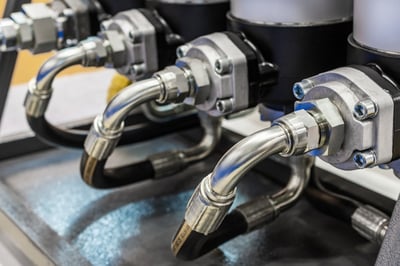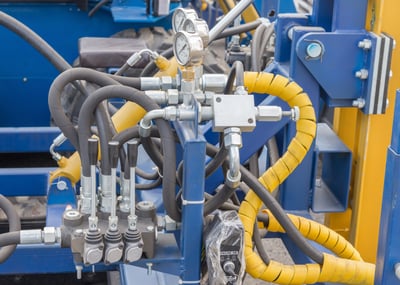Hydraulic systems are found in a wide variety of applications, from small assembly processes to large capacity integrated steel mills, earth moving equipment, chemical and food & beverage processing, aerospace and just about anywhere where there is a need to control the movement of some type of mechanism. Hydraulics enable significant work to be accomplished from lifting heavy loads, oil and gas drilling, turning mining augers and much more.
Hydraulic hose fittings connect hydraulic hoses and tubes together and connect to valves, pumps, motors, cylinders, reservoirs, filters, accumulators, sensors, and other components in the hydraulic system. And it goes without saying how critical it is to pick the right combination of fitting, hose, and tube. Otherwise, you will likely be faced with system failure, a decrease in the efficiency of the hydraulic system and even cause significant safety issues. All of which will cost time, money, and the potential of injury.
Knowing the Right Components for the Application
The correct selection of hydraulic components can be different depending on the specific operating requirements and is critical to handle changes in pressure, maintain safety and extend the service life of the system. One system may have just steel hydraulic fittings and standard elastomeric hydraulic hose, while another may require fittings along with both flexible hose and metal tubing. For instance, in a food and beverage plant one part of the system may require flexible hose carrying hydraulic fluid to control moving parts, and another part of the same system may require stationary stainless steel fittings and tube that are conveying food product. While in other severe environments, hydraulic hose assemblies in the agricultural, mining and construction industries have to be flexible and withstand harsh conditions. Flexible hose consists of a cover, reinforcement, and tubing. Hydraulic fittings hold and guide the fluid, help maintain pressure and when properly installed, prevent leaks. With the many different types and configurations of hydraulic hose fittings, it is easy to change the direction of the hose, and hence the flow, as well as the elevation of lines. Yet it is also imperative in some applications that their design must remain permanent and withstand years of service in severe conditions.
critical to handle changes in pressure, maintain safety and extend the service life of the system. One system may have just steel hydraulic fittings and standard elastomeric hydraulic hose, while another may require fittings along with both flexible hose and metal tubing. For instance, in a food and beverage plant one part of the system may require flexible hose carrying hydraulic fluid to control moving parts, and another part of the same system may require stationary stainless steel fittings and tube that are conveying food product. While in other severe environments, hydraulic hose assemblies in the agricultural, mining and construction industries have to be flexible and withstand harsh conditions. Flexible hose consists of a cover, reinforcement, and tubing. Hydraulic fittings hold and guide the fluid, help maintain pressure and when properly installed, prevent leaks. With the many different types and configurations of hydraulic hose fittings, it is easy to change the direction of the hose, and hence the flow, as well as the elevation of lines. Yet it is also imperative in some applications that their design must remain permanent and withstand years of service in severe conditions.
As a case example: subsea separators and processing units include many different processes. They involve sand and solid separation, subsea water removal, single and multi-phase boosting of well fluids, and gas or liquid separation. Subsea systems are usually many thousands of feet underwater and can weigh as much as 1,000 tons (907,185 kg) each. Clearly, the cost of bringing a subsea separator to the surface for maintenance is prohibitive. That’s why the hydraulic system components must be able to withstand a harsh deep-sea environment and without the need for maintenance for at least five years. This is a prime example of why component selection is so important.
The STAMPED Process
Most people working in hydraulics are familiar with the STAMPED process of hose and fitting selection, endorsed by The Association of Hose and Accessory Distributors (NAHAD). STAMPED stands for Size, Temperature, Application, Material/Media, Pressure, Ends, Delivery.
- Size refers to the inner and outer diameters, and overall assembly length. The ID of the hose must be large enough to minimize pressure losses and prevent damage to the assembly from heat or excessive flexing.
- Temperature of the fluid and that of the environment must be within the rated limit of the hydraulic hose. However, some materials, such as PTFE-based hose, have higher ratings. Yet, exceeding the rated temperature will significantly reduce hose and system life, or even damage equipment and cause other safety issues.
- Application will always drive the selection of components. For replacement hydraulic fitting and hose, it is usually best to use the same types and styles as the original assembly, unless the application conditions have changed.
• Material/Media is the type of fluid (media) being conveyed. When selecting components, material, pressure, and temperature must be considered, as well as the environment the hose cover is exposed to. Other considerations are the impact of saltwater, chemicals, UV light, ozone, and anything that can impeded service life or cause drastic failure. - Pressure that the assembly will be exposed to is critical. Hose assembly pressures must be equal to or exceed the working pressure of the system and consideration of potential spikes. Hydraulic fittings, like hose, have their own specific pressure ratings, so it is essential to use the lesser of rating as the maximum for the assembly.
Many engineers and maintenance personnel only refer to STAMP, ending with pressure. However, some add two more letters that are rather obvious, but must not be overlooked — the E and D. - Ends are the termination end style, orientation, type, and method of attachment. Which in most cases should follow the equipment OEMs standards in original set-up and maintenance.
- Delivery is literally that; how the product (i.e., hose and fittings) is delivered from the manufacturer or distributor to the end user, to storage, and right out to the field. The components must be tested, cleaned (or pre-cleaned at the manufacturer) and should be stored with protective caps on the ends until installed in order to keep out debris.
Conclusion
 Hydraulic hoses, fittings, and tubing are the arteries of the system. They transfer fluid from the pump to valves, and then to other components that generate the power that allows the system to work. A processing system’s ability to be reliable and repeatable is what helps to avoid costly downtime. Research conducted by Vanson Bourne and Aberdeen research groups showed that 82 percent of companies have experienced at least one unplanned period of downtime over the three years of the study, which costs companies $250K per hour, equaling more than $2 million in losses.
Hydraulic hoses, fittings, and tubing are the arteries of the system. They transfer fluid from the pump to valves, and then to other components that generate the power that allows the system to work. A processing system’s ability to be reliable and repeatable is what helps to avoid costly downtime. Research conducted by Vanson Bourne and Aberdeen research groups showed that 82 percent of companies have experienced at least one unplanned period of downtime over the three years of the study, which costs companies $250K per hour, equaling more than $2 million in losses.
Reduced maintenance and downtime help ensure long service life of a hydraulic system. This is predominantly a result of proper hose, fitting and tubing selection, all of which can significantly impact operational costs and revenue goals.
